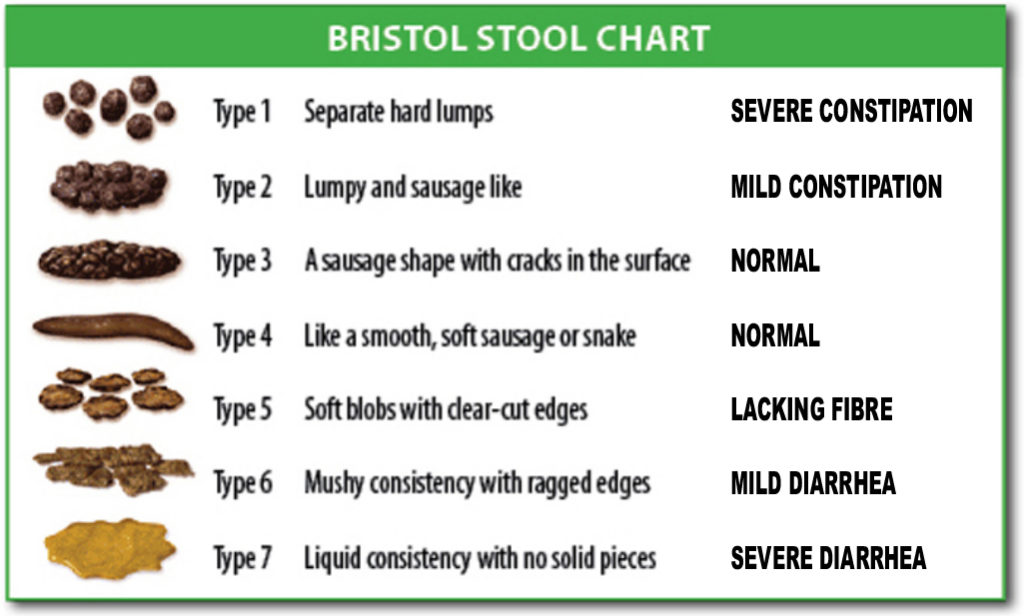Poop may be one of the best predictors of our general health. It goes by a variety of names including feces or faeces, stool, bowel movement and a bunch of others we won’t repeat here. It’s something that seems quite embarrassing to discuss out loud so we barely acknowledge it even in the privacy of our own bathrooms. A good poop is, however a great feeling and in some cases worthy of a silent cheer! OK, it’s hardly dinner conversation or cocktail chat but it is important to be aware of your personal normal so that you can tell when your diet needs an alteration or you need to consult your health care team.
First, what is poop? Roughly 75% water to begin with, but mixed into it is fibre, bacteria – both living and dead – a bunch of cellular material and mucus. It’s also well-travelled, needing to manage approximately 25 feet or 7.6m of digestive tract before it exits the human body.
Poop comes in a variety of forms and colours depending on the foods we eat and the medications we take. Your personal normal may see you poop every other day or three times every day. Activity levels also play a role. The less active one is, the slower the bowels can perform. Aging can play a role in changing how the entire body functions and your poop is likely to be part of those changes.
What is generally considered to be normal poop is a brown coloured, unpleasant smelling, log shaped piece of bodily waste. The colour comes from broken down blood pigments but is influenced by the foods we eat, the medications we take, the speed at which the poop moves through the digestive tract and problems with other parts of the body. For example, some orange in your poop can be the result of eating a lot of carrots or sweet potatoes but a blocked bile duct can have the same result.
The odor comes from what you eat and the bacteria in your digestive system. If you eat a lot of soluble fibre such as legumes, oatmeal, fruits and vegetables like Brussels sprouts, sweet potatoes and asparagus, they will dissolve in the water in your intestines becoming sticky, binding to bile and then exiting the body. On the other hand, if your diet includes a lot of insoluble fibre like cereal grains, bell peppers, cabbage, lettuce and onions, they don’t dissolve in water but they absorb water which causes them to bulk up and make us feel fuller but also clean the intestine as they move through our system. Many foods contain both soluble and insoluble fibre. Apples, for instance, have good soluble fibre on the inside but the skin is a great source of insoluble fibre.
The shape of your poop is a whole education on its own. The Bristol Stool Scale is the result of a large study done on 2000 men and women in England and put forward by the authors, Dr. Stephen Lewis and Dr. Ken Heaton, as a clinical assessment tool. The chart below shows the seven different types of shapes along with the descriptions and indications. Not surprisingly, shape can vary with medication and diet. What is interesting is that of the study participants, females tended to have more type 1 and 2 stool shapes while men had more type 5 and 6 stool shapes.

Understanding your ‘normal’ poop should be relatively easy. When you poop, look before you flush. If you see something that doesn’t look quite right to you, consider what you’ve been eating the past couple of days before you panic. Bright red in your poop might mean that you ate a lot of beets or had one too many Bloody Marys. Black in your stool might be a result of iron supplements. If bright red or black aren’t caused by something you ate, call your doctor straight away. Anything that goes on too long or gives you cause for concern should mean a call to your health care team to get checked out.
On the lighter side, the differences between men and women seems to extend to their tolerance levels. Men, who tend to have softer stools according to the Bristol research, seem to have less tolerance for softer stools from their children. That may be a topic for another day however this video is a favourite that most mothers can relate to!






Add Your Voice
0 Comments
Join the Discussion